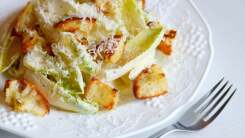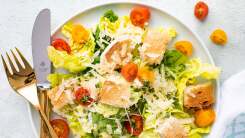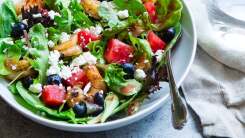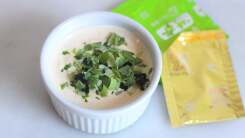11 Secrets to Building a Better Salad
It would surprise most people to know that my bologna-loving self is really good at making delicious salads. Even self-proclaimed salad haters have been wooed by my artfully arranged piles of leaves and stuff. As one might expect, I have many strategies, tips, and tricks for making special-tasting salads, and I would like to share them with you.
Relying on your dressing to provide all of the seasoning for your salad is a rookie salad-making mistake. Like any dish, your salad is greatly improved by showing each component a little love and attention. This means seasoning your leaves and other vegetables with salt and pepper at the bare minimum, but don’t be afraid to get a little monosodium glutamate or nutritional yeast involved—every single salad is better with a little extra umami. (Bonus benefit: you’ll need less dressing.)

Once you’ve sprinkled on your flavor powders and crystals, consider flavoring your big leaves with smaller, more aggressively flavored leaves, also known as “herbs.” I like to match my herbs to my dominant non-leaf ingredient. Salads heavy on tomatoes get oregano and/or basil, grilled chicken gets tarragon or dill, and in-season fruit is paired with fresh mint. Chives are pretty universal, and particularly helpful if your salad features a lot of cheese, meat, or egg.
Mixing and matching various flavors and textures on top of a pile of leaves isn’t as challenging as say, pastry work, but it’s easy to end up with a salad that’s too dry, too cheesy, or—the absolute worst—bland.

Luckily, there are many classics you can look to and learn from. Examine their components, and think about what each one does. Which ones are providing richness? Which ones are providing texture? Which ingredients are keeping it fresh? Answer these questions, then start thinking about swaps and subs.
Homemade salad dressings can be a deeply personal thing, but I have found that the ratios in the above graphic churn out delicious vinaigrettes every time. You many notice the oil-to-acid ratio is a little higher than what you might be used to, but most dressings call for far too much oil.

As A.A. Newton has explained before, the “‘classic’ 1:3 ratio [of vinegar to oil] sucks because it throws the balance between acidity and salt that makes a good vinaigrette, well, good. Adding too much oil dilutes the flavor you worked so hard to build with carefully chosen vinegars, minced aromatics, mustard, sugar, and herbs...The perfect vinaigrette is intense enough that a few tablespoons is all you need to dress a huge bowl of greens—you’re not supposed to be able to happily slurp it down by the spoonful. The punchier and sharper, the better.”
A mason jar—or any jar with a lid—is the only tool you need for perfectly emulsified dressings. Not only is a jar cheaper than those single-use, “emulsifying” salad dressing bottles, it is much more effective. Just pour your ingredients in the jar, close the jar, and shake the jar. You now have a beautifully homogenous vinaigrette.
Making a good dressing is all about striking that perfect balance of flavors. Sugar obviously adds sweetness, but it also balances out the acidic bite from the vinegar and tempers saltiness, and just makes things taste better. A little bit is all it takes make your dressings feel more finished. I usually use plain simple syrup, because it goes into solution so easily, but maple, agave, honey, or any other liquid sweetener can be used for the same effect.
Like sugar, vanilla is a flavor pretty firmly associated with dessert, but it’s really the flavor of indulgence. Just a touch of vanilla extract can soften acidity, accentuate sweetness, and just make your dressing feel more decadent. Vanilla-tinged dressings work best with salads that feature ingredients with naturally occurring sweetness—think fruit or roasted vegetables—super salty ingredients, or a really aggressive cheese.

Bringing a big fork of salad to one’s mouth, only to be hit in the face with a large wet and floppy leaf is an experience most salad-eaters have experienced multiple times. Salads should be a fork-only operation, and every component should be sliced or chopped so it fits easily inside one’s mouth. This can make prep work tedious, but only if you try to do everything with a knife. A good pair of kitchen scissors makes things so much easier.

I actually can’t remember the last time I used single blade to make a salad. I just throw everything—lettuce, olives, cherry tomatoes, whole scallions, and any proteins—in a bowl, then stick the scissors in (perpendicular to the bowl), and chop, chop, chop until it all fits easily on the fork. You can even add dressing and use the blades of the scissors to gently toss all of the ingredients together.
Most people think of croutons as one thing—cubes of stale and toasted bread that hurt your mouth a little. I love them, and I would never suggest you abandon traditional croutons entirely, but I would like to encourage you to mix it up.

You can, for example, make your croutons with soft and squishy hamburger buns, which soak up fat like little sponges and brown super easily thanks to their high sugar content. You could also abandon bread and embrace potatoes. Tater tots are the perfect shape and size for a salad, but I have been known to top my salads with potato chips and french fries (though not usually at the same time).
Good olive oil has a very distinct flavor, but sometimes that flavor is not what you’re going for with a vinaigrette. If you’re highlighting something other than your expensive EVOO, like a punchy vinegar or some herbs from your garden, consider using a more neutral oil so you don’t obscure your star flavors.

On the other end of the spectrum, we have animal fats, which steal the show completely. If I’m going to go through the trouble of searing a steak for a salad, I don’t want to waste those pan juices. They’re so flavorful, they rarely need anything besides a little lemon for contrast. Just pour the hot grease directly on your greens, squeeze on your acidic citrus, and pile on the rest of your salad ingredients.
Bacon fat can do similarly wonderful things. The hot grease wilts and seasons your greens creating a perfect foundation for lots of contrasting fresh and crunchy vegetables, super sour vinaigrettes, and hot sauce. (Hot bacon grease is also very good on fresh tomatoes). If you don’t have any hot and fresh bacon grease, you can use the saved stuff to whip up a meaty vinaigrette.
Eating a big salad off of a plate is a fool’s errand, as is eating one from a soup or salad bowl. The correct vessel for such a salad is a large mixing bowl, especially if you are making a meal out of it.
Unlike plates, mixing bowls are deep with high, sloped walls, which keep the slippery, vinaigrette-coated bits in the bowl. A plate doesn’t have any walls, meaning vegetables and such can just go flying about, unchecked. You can also prepare the salad in the bowl and then eat it from that same bowl, cutting down on the number of dishes you have to wash, which is always a plus.
Claire is Lifehacker's Senior Food Editor. She has a B.S. in chemistry, a decade of food journalism experience, and a deep love for mayonnaise and MSG.
RECOMMENDED NEWS

Make Five Festive Christmas Cookies From One Simple Dough
The last three weeks have been a whirlwind of peppermint mochas, ugly sweaters, Secret Santas, and c...

Make Jalapeño Popper Charcuterie Bites With Pizza Dough
Among the many important, society-shaping innovations the ‘90s brought us–Playstation, text messagin...

Celebrate National Sandwich Day by Putting Mayo on Your Breakfast Sandwich
Today is an important day; an exciting day; a day we’ve all been waiting for. That’s right: I’m talk...

This Is How You Fix a Messy Summer Ice Cream Cone
Perhaps you have noticed that I have been thinking and writing about ice cream an awful lot. Hot wea...

You Can Proof Bread in Your Instant Pot
It’s a bit ironic that the best time to bake bread (a cold, dark day) is the worst time to proof (or...

How to Cook Grits in Your Instant Pot
I will never understand people who don’t like eating grits, but I do understand people who don’t lik...
Comments on "11 Secrets to Building a Better Salad" :